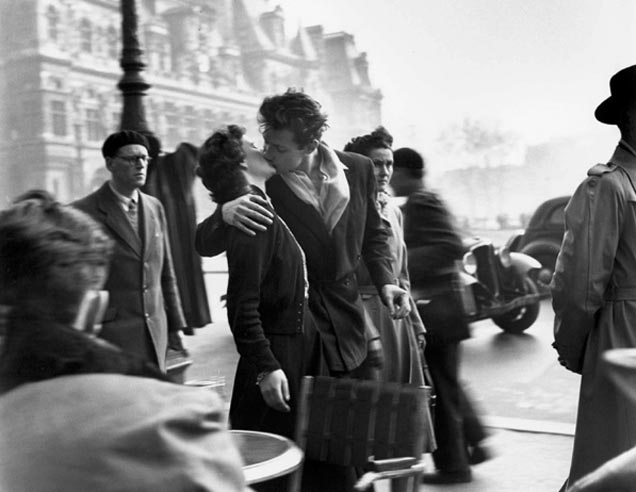 NY:
NY: Monday's Google doodle features one of Robert Doisneau's most famous shots: an image of two lovers kissing. But this Robert Doisneau photo has a surprising history.
French photographer Robert Doisneau, who is being feted with a Google Doodle Monday, is renowned for his work depicting everyday moments in the life of Parisians. One of his most famous photos, “Le baiser de l'hôtel de ville (The Kiss by the Hôtel de Ville),” a picture of a couple kissing that has graced thousands of postcards and posters, seems to be the epitome of his spontaneous style.
However, after it became a classic photo – forever associated with Paris and romance – it provoked lawsuits, including one that cast the photo’s serendipity in a new light.
The photo was taken by Doisneau in 1950 for Life Magazine after Doisneau was instructed to get shots of couples in Paris for a spread. Its popularity erupted years later, when a publisher asked Doisneau in 1986 if he could use the photo for a poster and Doisneau allowed it.
At least one couple incorrectly believed themselves to be the two seen embracing in Doisneau’s photo. Jean and Denise Lavergne told him so over lunch one day. At the time, Doisneau said nothing to disprove their statement. Still believing themselves to be the couple, the Lavergnes sued Doisneau for more than $18,000, claiming that he had used their likenesses without permission. A second suit came around the same time from a woman named Françoise Delbart (who now goes by her married name of Françoise Bornet). She sued the photographer in 1993 for a share of future sales and an additional $3,773.
Because of the two lawsuits, Doisneau revealed that the picture had in fact been staged after he had seen Ms. Bornet and Jacques Carteaud kissing and asked them if they could do it again for a photo. Doisneau then photographed Bornet and Carteau, both hopeful actors, in three different locations, which included the final location of near the Hôtel de Ville. After they posed, Doisneau gave Bornet a print of the photo with his stamp and signature.
Courts dismissed the claims of both the Lavergnes and Bornet in 1993, saying that the photo couldn’t be used to positively identify anyone in it.
Bornet auctioned her print of the photo in 2005, where it was sold for the equivalent of $242,000.
“The photo was posed,” Bornet said in an interview with French media. “But the kiss was real.”
Another photograph on the doodle is titled Le Remorqueur du Champ de Mars (Tug on the Champ de Mars). The 1943 image shows two children playing near the Eiffel Tower in Paris. Another is the image of a woman (said to be representing the anonymous reader) at the 19th-century French writer Guy de Maupassant's monument in Paris. The fourth photograph reportedly is Le Chien a Roulettes (Dog on Wheels) from 1977.
He is widely acclaimed for his ironic images as well as those that depicted juxtapositions. Doisneau's pictures mingled social classes and eccentricities of contemporary Paris life.
Doisneau lost his parents in childhood. His father died during World War I when he was only four, he lost his mother too when he was seven. He was raised by his aunt.
At 13, Doisneau joined a craft school where he got his first introduction to arts, participating in still life and figure drawing. He earned diplomas in lithography and engraving here.
Doisneau is said to have discovered photography when he was 16. According to some accounts in the initial days of his photography, he was so shy that he only photographed cobblestones.
In the 1920s, he joined an advertising company. In 1932 he sold his first photo-story to Excelsior magazine. In 1934 he was recruited as an industrial advertising photographer at Renault car factory. In an article in 1991, he admitted that the years at the Renault marked "the beginning of his career as a photographer and the end of his youth."
In 1939, he lost his job at Renault, and was forced to takeup freelance advertising, engraving and postcard photography to earn his living. In the same year, he got a job with Charles Rado of the Rapho photo agency. During this time, he travelled across France in search of picture stories and took his first professional street photographs.
As the World War II started, he was drafted as a photographer and a Resistance soldier. He reportedly used his skills to forge identification papers and passports. During this time he photographed the Battle of Paris. Post World War II, he joined Life magazine. He also did some fashion and high-class photography with Paris Vogue. He received the Prix Kodak in 1947.
 NY: Monday's Google doodle features one of Robert Doisneau's most famous shots: an image of two lovers kissing. But this Robert Doisneau photo has a surprising history.
NY: Monday's Google doodle features one of Robert Doisneau's most famous shots: an image of two lovers kissing. But this Robert Doisneau photo has a surprising history.